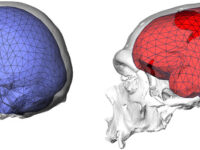It’s a great wonder how organisms remain at a constant temperature, despite many outside influences like freezing winds or heat waves. Maintaining proper body temperature is key for most organisms. The temperature-controlling systems in mammals are extremely complex and well-designed, ensuring that they maintain homeostasis. For these animals, the environmental temperature can be sensed by external receptor cells such as thermoreceptors located on the skin. Transient receptor potential (TRP) channels, located in the plasma membrane of many animal cells, have been discovered to be extremely important in thermosensory reception.
TRP cationic channels mediate the influx and efflux of ions into cells in response to chemical or physical stimuli. There are many different human cell types in which TRP channels are present, such as keratinocytes, sensory neurons, melanocytes, and inflammatory cells. TRP channels have many functions in human cells, ranging from feeling sensations to skin homeostasis. These channels are essential to bodily functioning and, if gone wrong, can lead to chronic pain and itching.
Transient receptor potential (TRP) channels … have been discovered to be extremely important in thermosensory reception.
In human skin, TRP channels can be activated by increases and drops in temperature. This temperature fluctuation can lead to the conversion of cells into heat and cold sensors. There are specific heating and cooling TRP channels that respond to their respective hot or cold stimuli.
A cold-sensitive TRP channel, TRPM8 is a non-selective cationic channel that can be activated by cold temperatures between 25 and 18 degrees Celsius. Another TRP channel called TRPA1 allows for the sensation of cold-painful temperatures that are below 18 degrees. TRPA1 is activated at lower temperatures than TRPM8 and is shown to have an outward cationic current with similar permeability for Ca2+ and Na+ ions. An experiment was performed on mice to examine the sensation of cold stimuli by both the TRPA1 and TRPM8 channels and published in the journal Frontiers in Cellular Neuroscience. Scientists compared TRP effects with visceral (NG) neurons (which conduct impulses from inside organs such as the heart and liver) versus somatic neurons (which conduct impulses from skin, muscles, and joints). After being stimulated with a cold sensation, the TRPA1 mice did not seem to have any difficulty sensing cold stimuli through the skin, while the TRPM8 mice had a reduced response to the same stimuli. In the paper Ion Channels and Thermosensitivity: TRP, TREK, or Both?, about 50 percent of NG neurons in culture were activated by cooling through TRPA1 channel activation. Overall, the data suggest that TRPA1 is the principal ion channel involved in cold sensation in NG neurons while TRPM8 fulfills the same role in somatic neurons. Cold activation of nerves can produce one of two sensations: moderate cold produces a sensation of pleasant coolness, while more intense cold produces a sensation of pain that triggers reflexes allowing animals to avoid tissue damage.
In human skin, TRP channels can be activated by increases and drops in temperature.
As for the heat-sensitive TRP channels, four TRP subtypes are activated by temperature increases, according to a study in the International Journal of Molecular Sciences. Two of them respond to warm stimuli (TRPV4 to temperatures over 27 degrees and TRPV3 to temperatures over 34 degrees), and the other two respond to hot-painful stimuli (TRPV1 to temperatures over 43 degrees and TRPV2 to temperatures over 52 degrees). It has been shown that TRP channels contribute more to the speed with which mice select a more comfortable temperature than to the value of the temperature itself. TRPV4 channels are more likely to be involved in choosing the preferred temperature from a non-painful range. Furthermore, TRPV3 channels can transmit thermal stimuli through skin keratinocytes, which then transmit this information to nerve endings.
Studying cold-sensitive and heat-sensitive TRP channels in mice allows us to expand these results to human skin and how we process extreme temperatures to maintain homeostasis. By understanding how our internal body temperature systems work, we can go outside and brave the cold knowing that our TRP channels are working to keep us warm!
Frontiers in Cellular Neuroscience (2020). DOI: 10.3389/fncel.2020.00262
International Journal of Molecular Sciences (2019). DOI:10.3390/ijms20102371
Pharmaceuticals (2016). DOI: 10.3390/ph9040077






